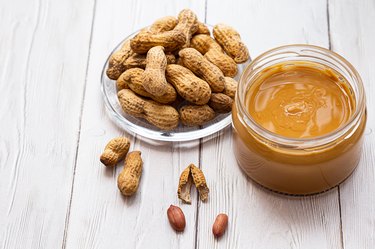
If you love nut butters but have diverticulosis, you may be wondering if you can eat peanut butter with a diverticulitis flare-up — and when it's safe to do so. Ultimately, while peanut butter is not a trigger food per se, whether you can eat it depends on timing.
If you have diverticulosis, but you're not experiencing a diverticulitis flare-up, eating fiber-containing foods like peanut butter and other kinds of nuts is safe, says New York City-based Lisa R. Young, PhD, RDN, registered dietitian nutritionist and adjunct professor of nutrition at New York University.
Video of the Day
Video of the Day
As the U.S. National Library of Medicine (NLM) explains, diverticulosis describes a usually asymptomatic condition in which small pouches form on the walls of your tube-like intestine (aka diverticula). While the exact cause is unknown, age and a low-fiber diet appear to be risk factors.
Diverticulitis, NLM says, is a flare-up that occurs when those pouches become infected or inflamed, resulting in abdominal pain and other symptoms — ranging from fever, bloating and nausea to, in more serious cases, bleeding, blockages or severe infections in the abdomen.
Eating Peanut Butter With Diverticulitis
Eating fiber-containing foods like peanut butter and other kinds of nuts is safe if you have diverticulosis, as long as you're not experiencing a flare-up of your diverticulosis (or diverticulitis), Young says.
However, if you are having a flare-up (when the diverticula become inflamed or infected), you will want to avoid peanut butter for the time being.
"During a diverticulitis flare-up, it is recommended to have a clear liquid or low-fiber diet for a few days until the symptoms ease up," Young says. "During that time, peanut butter and other foods with fiber (fruits, veggies, nuts) are not recommended."
According to the Stanford University Medical Center, cutting your fiber intake during a diverticulitis flare-up often means fewer bowel movements — and, in turn, less gastrointestinal pain and discomfort.
What to Eat During a Diverticulitis Flare-Up
If you are having a flare-up, Young says that "clear liquids, such as chicken broth, are recommended."
A clear-liquid diet for severe diverticulitis flare-ups can, per the Cleveland Clinic, include:
- Water.
- Fruit juices without pulp.
- Ice pops.
- Gelatin foods like Jell-O.
Usually, per NLM, you will start with a liquid diet that gradually reintroduces soft, easy-to-digest foods so as to give your colon time to rest and heal.
That said, if your flare-up is deemed mild, the Cleveland Clinic advises that you eat no more than 8 to 12 grams of fiber a day, with such ideal low-fiber options as:
- White breads and pastas.
- Meats.
- Eggs.
- Seafood.
- Low-fiber fruits (canned peaches, ripe bananas).
- Greek yogurt.
- Cottage cheese.
Foods to Avoid After Diverticulitis Attack
According to NLM, after an attack, while your colon is healing, you may be asked to avoid such foods as:
- Whole-grain foods.
- Fruits.
- Vegetables.
Notably, these are the same high-fiber foods that, once you are better, your doctor will suggest you add more of — and which also may help prevent future attacks, per NLM. Your doctor will also help you determine which specific foods are best for you to avoid.
Keep Flare-Ups at Bay
In general, eating a fiber-rich diet may help reduce your likelihood of having diverticulitis flare-ups, according to the NLM.
Once your provider clears you to eat high-fiber foods, the NLM suggests the following dietary choices:
- Fruits (tangerines, prunes, apples, bananas, peaches, pears).
- Tender cooked vegetables (asparagus, beets, mushrooms, turnips, pumpkin, broccoli, artichokes, lima beans, squash, carrots, sweet potatoes).
- Lettuce and peeled potatoes.
- High-fiber cereals (shredded wheat), muffins.
- Hot cereals (cream of wheat, oatmeal, farina).
- Vegetable juices.
- Whole-grain breads, (whole rye, whole wheat).
Read more: 19 High-Fiber Foods for Better Heart and Gut Health
When to Call a Doctor
The NLM advises you to call your doctor if your diverticulitis symptoms don't disappear or if they worsen after several days of treatment.
Warning signs to watch out for, according to the NLM, include, among other symptoms:
- Having chills.
- Nausea.
- Vomiting.
- Persistent fever above 100.4 degrees Fahrenheit.
- Intense pain in your back or abdomen.
- Bowel movements that contain blood.
- Cleveland Clinic: “What Foods Should You Eat — and Avoid — on a Diverticulitis Diet?”
- Lisa R. Young, PhD, RDN, CDN, registered dietitian nutritionist; adjunct professor of nutrition, New York University, New York City
- Stanford University Medical Center: “Low-Fiber Diet for Diverticulitis”
- U.S. National Library of Medicine: “Diverticulitis”
- U.S. National Library of Medicine: “Diverticulitis and Diverticulosis – Discharge”
Is this an emergency? If you are experiencing serious medical symptoms, please see the National Library of Medicine’s list of signs you need emergency medical attention or call 911.